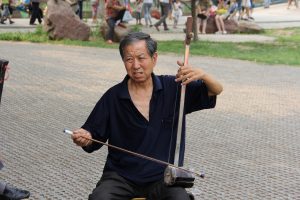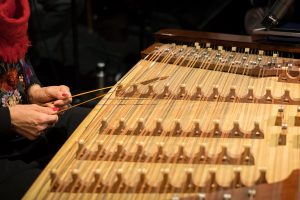Cantonese Opera is a performance style that uses a complex sound range and a diverse orchestration of instruments to complement several aspects of Cantonese Opera. Musical Instruments are an important aspect of Cantonese Opera that are worth more exploration!
Introduction to the Music of Cantonese Opera
Since the 1930s, Cantonese Opera has used Cantonese instrumental music called ching yam (Wertz). The use of instruments in Cantonese Opera is influenced by Chinese musical traditions and Western influence. In Chinese music, instruments and compositions are broken down into eight categories or tones called bayin (Randel). These categories are metal, clay, gourd, silk, bamboo, wood, stone, and skin (Randel). Much of the music in Cantonese Opera comes from traditional Chinese music theory and other Chinese theater traditions.

The Ensemble
While Cantonese Operas are being performed, there is a large ensemble that plays the music to accompany the show. The ensemble is known as pengmian (Suk-yan). Within the ensemble, the instruments are broken down into a melodic (xile) and percussion (zhogle) section. The melodic section includes all of the different wind and string instruments like the ehru. The ehru usually leads the ensemble while the percussion section dictates the rhythm and pace of the music and opera (Wertz).
Because there are so many different kinds of instruments, the size of the ensemble ranges from just a few musicians to almost 50 musicians (“The Instruments”). The instruments are mainly traditional Chinese instruments but in the last half-century there have been more usage of Western instruments in some ensembles. The pengmian or ensemble’s main roles are to accompany the singer(s), create sound effects, and help create a dramatic mood (Suk-yan).
The Instruments
Most Commonly Used Instruments

Erhu: The Erhu is one of the most important and impressive instruments used in a Cantonese Opera ensemble. It usually leads the ensemble and has a big range of sounds and emotions that it can play. It has two strings, a long neck, snakeskin sound box, no fingerboard, the strings are played against each other, and the bow is always connected to the instrument (“Erhu”).
Pipa: Commonly referred to as the “King” of Chinese folk instruments, the Pipa is a lute-type instrument with four strings. It is played vertically like a erhu. Although similar is look, the pipa is rather different than a guitar. According to the Shen Yun Performing Arts website, “its body, by traditional Chinese measurement, is three feet five inches, representing the three powers—heaven, the earth, and man, and the five elements—metal, wood, water, fire, and earth. Meanwhile, the four strings represent the four seasons” (“Pipa”).
Dizi: The Dizi is a bamboo flute which produces a sweet and bright sound range which has a unique timbre and tone. There is an extra hole between the finger holes and blow holes which is covered by a small reed membrane that allows for more resonant qualities to the instrument. The Shen Yun Performing Arts describes the instrument as having “an inherent ethereal quality. When played in the middle and upper registers with a quick breath attack, the dizi gives the listener a lofty, sprightly feeling, as if floating. Played in its lower registers with a soft breath attack, however, it can bring one to peaceful and grounded retrospection. The dizi is also famous for its ability to imitate sounds of nature. It can reproduce the aural environment of a forest so accurately that natural landscapes often appear vividly in a listener’s imagination” (“Dizi”).
Suona: A Suona is the most commonly used double-reed woodwind instrument in Chinese music and is frequently used in Cantonese Opera ensembles. (Britannica, The Editors of Encyclopaedia, “Suona”).
Yangqin: The Yangqin is an interesting stringed instrument from the dulcimer family. It is played with bamboo beaters or by hand. The arrangement of the strings allows for the musician to play a chromatic scale easily. (Britannica, The Editors of Encyclopaedia, “Yangqin”).

Other Instruments
There are many different other instruments that are used in Cantonese Opera ensembles. Some even feature Western instruments like the violin and saxophone. Other frequently used instruments are: the Gong (of many different sizes and material), the Pengling, the Qingi, the Gaohu, the Sanxian, the Yangqin, the Ban, the Bangzi, the Bo, the Yueqin, the Sheng, the Danpigu, and the Daluo (Music in Cantonese Opera (Yueju)).
An Analysis of the Instruments used in “Double Suicide”
Act VII of The Flower Princess by Tong Dik Sang is called “Double Suicide” and is one of the most well-known scenes in Cantonese Opera. The scene itself is representative of most Cantonese Operas, including the structure and musical elements. By looking at how music is used in “Double Suicide,” the strong relationship between music and this play will be revealed.
For Cantonese Operas, the scripts are an extremely valuable source to the actors, readers, and the musicians. According to the Bell Yung in an introduction to the Flower Princess, “The scripts for Cantonese Operas “play a critical role as a blueprint for performance: in addition to containing the libretto, they also provide directives for singers and instrumentalists, the most important of these being the titles of the tunes and speech types to which texts are to be delivered” (Sang and Yung 10-11).
The musicians play an integral role for the actors. They queue actors into certain songs, they provide a mood for a scene, they accompany an actor when they are singing, and they make the play music in general. The scripts help musicians know what to play for each scene. Subsequently, each musician for each instrument knows when they should play.
In “Double Suicide,” the song that is written in the script is “Autumnal Thoughts by the Dressing Table,” which is a Siukuk tune. A Siukuk tune is one that has a distinctive and catchy melody. Yung writes that “scriptwriters choose them mainly for lyrical moments when actors express their internal thoughts and emotions” (Sang and Yung 12).
As the scene starts, there is background percussion or zhogle. Various gongs and other instruments like the bangzi are played while the scene opens. Then there is the dizi, a flute, that sets an initial tone of celebration. The celebrations are for the wedding. Immediately afterward, the music stops and Princess Cheungping says her first line.
So far the music is setting the mood. After Princess Cheungping and Saihin say each of their lines, there is percussion that gives emphasis to each performer’s lines. It has now become a very auspicious mood because of the use of silence between instrumentation.
The final song, “Autumnal Thought by the Dressing Table,” begins with the addition of more instruments, such as the erhu and pipa. The music accompanies the two actors. It keeps the rhythm and dictates the pace.
It is especially striking musically, at the end of the of the scene, where Cheungping and Saihin do the double suicide— there is loud percussion that is both scattered and fragmented. Overall, the music complements the film’s narrative through the instrumentation of song. The different instruments, lead by the erhu, provide a necessary foundation for the actors to sing their songs. The music plays an essential role in establishing the mood of different parts of the Cantonese Opera. Although other forms of theater use music, Cantonese Opera uses a broad range of instruments to create its vivid soundscapes to each performance. By looking at “Double Suicide,” one can imagine the potential the music has for contributing to the overall character of these Cantonese Operas. The pengmian or ensemble is a necessary component of Cantonese Opera and its role cannot be overlooked. “Double Suicide” is a valuable case study for understanding the music in Cantonese Opera because it contains many of the central elements of Cantonese instrumentation and shows the way the theater can work with orchestras to create unique performance styles.
So what?
So what? What can we say about Cantonese Opera after learning about the music? Our understanding of the performance doesn’t change now that we know but it would change if there was no music. The music used in Cantonese Opera is both unique and necessary. It complements the narrative, mood, and aids the development of characters, plot, and themes. The unique and diverse range of instruments reflects this musically powerful performance style. The music is beautiful and is an essential characteristic of what we know as Cantonese Opera.
Writing Works Cited
Britannica, The Editors of Encyclopaedia. “Suona.” Encyclopædia Britannica, Encyclopædia Britannica, Inc., 3 June 2011, www.britannica.com/art/suona.
Britannica, The Editors of Encyclopaedia. “Yangqin.” Encyclopædia Britannica, Encyclopædia Britannica, Inc., 22 Dec. 2017, www.britannica.com/art/yangqin.
Dik-Sang, Tong, and Bell Yung. The Flower Princess: a Cantonese Opera. Chinese Univ. Press, 2010.
“Dizi.” Shen Yun Performing Arts, Shen Yun Performing Arts, 2018, http://www.shenyunperformingarts.org/learn/article/read/item/BkKQSMGL1A8/level-one/vjCERymxAIA/bamboo-flute-chinese-flute-dizi.html.
“Erhu.” Shen Yun Performing Arts, Shen Yun Performing Arts, 2018, http://www.shenyunperformingarts.org/learn/article/read/item/94I3V_FwFbM/chinese-music-instruments-erhu-violin.html.
“Featured Music and Musical Instruments of Cantonese Opera.” China.org.cn, China.org.cn, 14 Sept. 2010, www.china.org.cn/travel/2010-09/14/content_20927148.htm.
“The Instruments.” The Collection of Cantonese Opera Records at the Canadian Museum of Civilization, Canadian Museum of Civilization, www.historymuseum.ca/operacantonais/instruments-e.shtml.
“Music in Cantonese Opera (Yueju).” Cantonese Opera (Yueju) in Hong Kong, Education University of Hong Kong, 2015, www.ied.edu.hk/ccaproject/yueju/eng/music.php.
“Music.” Shen Yun Performing Arts, Shen Yun Performing Arts, 2018, www.shenyunperformingarts.org/learn/category/index/level-one/vjCERymxAIA/music.html.
“Pipa.” Shen Yun Performing Arts, Shen Yun Performing Arts, 2018, http://www.shenyunperformingarts.org/learn/article/read/item/mjN8kaB2zig/chinese-music-instruments-pipa-chinese-lute.html.
Randel, Don Michael, editor. “Chinese Music.” Harvard Dictionary of Music, 4th ed., Harvard University Press, 2003, pp. 260–262.
Randel, Don Michael. “Harvard Dictionary of Music.” Harvard Dictionary of Music, 4th ed., Harvard University Press, 2003, pp. 260–262.
Suk-yan, Tai. “Introduction to Cantonese Opera.” Hong Kong Education City, Hong Kong Education City Limited, www.hkedcity.net/res…/introduction_to_cantonese_opera_eng_upload_150825.pdf.
Wertz, Richard. “Cantonese Opera.” Chinese Opera, 1998, www.ibiblio.org/chineseculture/contents/entr/p-entr-c01s03.html#Musical%20Instruments.
Pictures Works Cited
Lee, Michelle. Yangqin. 11 February 2017. Flickr, https://tinyurl.com/ycpp2gh2. Accessed 21 April 2018.
Polywoda, V.T. Erhu player, Anyang, China. 1 June 2014.Flickr, https://tinyurl.com/y9lumazl.
Accessed 21 April 2018.
Suk-yam, Tai. Sheung Shui Kam Tsin Village. 5 March 2010. Hong Kong Education City Limited,
www.hkedcity.net/res…/introduction_to_cantonese_opera_eng_upload_150825.pdf.
Accessed 20 April 2018.
Yu, David. Red Bean Cantonese Opera Performance Show 1014. 27 July 2014. Flickr,
https://tinyurl.com/y8z8emvu. Accessed 21 April 2018.
Videos Works Cited
“Fragrant Sacrifice.” YouTube, uploaded by canaanoptical, 9 January 2011,
https://www.youtube.com/watch?v=5rgNRdbPdtg.
“The Erhu – A Closer Look.” YouTube, uploaded by Shen Yun Official Account, 11 October 2014,
https://www.youtube.com/watch?v=1GqVXBIqeT4&t=4s.
“The Pipa – A Closer Look.” YouTube, uploaded by Shen Yun Official Account, 15 April 2015,
https://www.youtube.com/watch?v=8bSFUAx5Zuk.